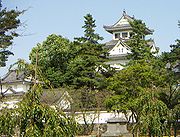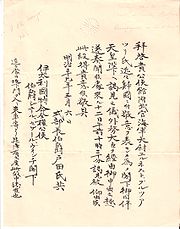
Ogaki Domain
Encyclopedia

Edo period
The , or , is a division of Japanese history which was ruled by the shoguns of the Tokugawa family, running from 1603 to 1868. The political entity of this period was the Tokugawa shogunate....
, located in Mino Province
Mino Province
, one of the old provinces of Japan, encompassed part of modern-day Gifu Prefecture. It was sometimes called . Mino Province bordered Echizen, Hida, Ise, Mikawa, Ōmi, Owari, and Shinano Provinces....
(modern-day Ōgaki
Ogaki, Gifu
is a city located in Gifu Prefecture, Japan. It was incorporated as a city on April 1, 1918. As of July 2011, the city has an estimated population of 160,999 and a total area of .Ōgaki was the final destination for the haiku poet Matsuo Bashō...
, Gifu Prefecture
Gifu Prefecture
is a prefecture located in the Chūbu region of central Japan. Its capital is the city of Gifu.Located in the center of Japan, it has long played an important part as the crossroads of Japan, connecting the east to the west through such routes as the Nakasendō...
).
History
Historically, the Ōgaki area had been a highly important point of transit from Mino ProvinceMino Province
, one of the old provinces of Japan, encompassed part of modern-day Gifu Prefecture. It was sometimes called . Mino Province bordered Echizen, Hida, Ise, Mikawa, Ōmi, Owari, and Shinano Provinces....
to Ōmi Province
Omi Province
is an old province of Japan, which today comprises Shiga Prefecture. It was one of the provinces that made up the Tōsandō circuit. It is nicknamed as .Lake Biwa, Japan's largest lake, is located at the center of the province...
; it was vital to Saitō Dōsan
Saito Dosan
was a daimyo who dramatically rose and also fell from power in Sengoku period Japan. He was also known as the for his ruthless tactics.-Life:Originally a wealthy merchant from Yamashiro Province , he entered the service of Nagai Nagahiro of Mino Province , assuming the name Nishimura Kankurô.He...
and later to Oda Nobunaga
Oda Nobunaga
was the initiator of the unification of Japan under the shogunate in the late 16th century, which ruled Japan until the Meiji Restoration in 1868. He was also a major daimyo during the Sengoku period of Japanese history. His opus was continued, completed and finalized by his successors Toyotomi...
. In the Edo period
Edo period
The , or , is a division of Japanese history which was ruled by the shoguns of the Tokugawa family, running from 1603 to 1868. The political entity of this period was the Tokugawa shogunate....
, the domain changed hands several times before it was given to the Toda clan, who held it until the Meiji Restoration
Meiji Restoration
The , also known as the Meiji Ishin, Revolution, Reform or Renewal, was a chain of events that restored imperial rule to Japan in 1868...
.

Boshin War
The was a civil war in Japan, fought from 1868 to 1869 between forces of the ruling Tokugawa shogunate and those seeking to return political power to the imperial court....
, first on the side of the Shogunate, and then as one of the components of the imperial army which was at the forefront of the offensive against Aizu
Aizu
is an area comprising the westernmost third of Fukushima Prefecture in Japan. The principal city of the area is Aizuwakamatsu.During the Edo period, Aizu was a feudal domain known as and part of Mutsu Province.-History:...
and the northern domains
Ouetsu Reppan Domei
-External links:**...
.
In the Meiji period
Meiji period
The , also known as the Meiji era, is a Japanese era which extended from September 1868 through July 1912. This period represents the first half of the Empire of Japan.- Meiji Restoration and the emperor :...
, the Toda family of Ōgaki received the rank of viscount (伯爵 hakushaku) in the new kazoku nobility.
List of lords
Ishikawa clanIshikawa clan
The ' was a Japanese family which claimed descent from Minamoto no Yoshiie. They took their name from the Ishikawa district of Kawachi Province. In the Sengoku Period, the family had two major branches; one of them, which had settled in Mikawa Province in the 15th century, was a family of retainers...
(Fudai
Fudai
was a class of daimyo who were hereditary vassals of the Tokugawa in Edo period Japan. It was primarily the fudai who filled the ranks of the Tokugawa administration.-Origins:...
; 50,000 koku
Koku
The is a Japanese unit of volume, equal to ten cubic shaku. In this definition, 3.5937 koku equal one cubic metre, i.e. 1 koku is approximately 278.3 litres. The koku was originally defined as a quantity of rice, historically defined as enough rice to feed one person for one year...
)
- Ishikawa Yasumichi
- Ishikawa Ienari
- Ishikawa Tadafusa
Matsudaira (Hisamatsu) clan
Matsudaira clan
The was a Japanese samurai clan that claimed descent from the Minamoto clan. It first originated in and took its name from Matsudaira village, in Mikawa Province . Over the course of its history, the clan produced many branches, most of which also centered around Mikawa Province...
(Fudai
Fudai
was a class of daimyo who were hereditary vassals of the Tokugawa in Edo period Japan. It was primarily the fudai who filled the ranks of the Tokugawa administration.-Origins:...
; 20,000 koku
Koku
The is a Japanese unit of volume, equal to ten cubic shaku. In this definition, 3.5937 koku equal one cubic metre, i.e. 1 koku is approximately 278.3 litres. The koku was originally defined as a quantity of rice, historically defined as enough rice to feed one person for one year...
)
- Matsudaira Tadayoshi
- Matsudaira Norinaga
Abe clan
Abe clan
The was one of the oldest of the major Japanese clans ; and the clan retained its prominence during the Sengoku period and the Edo period. The clan's origin is said to be one of the original clans of the Yamato people; they truly gained prominence during the Heian period , and experienced a...
(Fudai
Fudai
was a class of daimyo who were hereditary vassals of the Tokugawa in Edo period Japan. It was primarily the fudai who filled the ranks of the Tokugawa administration.-Origins:...
; 50,000 koku
Koku
The is a Japanese unit of volume, equal to ten cubic shaku. In this definition, 3.5937 koku equal one cubic metre, i.e. 1 koku is approximately 278.3 litres. The koku was originally defined as a quantity of rice, historically defined as enough rice to feed one person for one year...
)
- Abe Nagamori
- Abe Nobukatsu
Matsudaira (Hisamatsu) clan
Matsudaira clan
The was a Japanese samurai clan that claimed descent from the Minamoto clan. It first originated in and took its name from Matsudaira village, in Mikawa Province . Over the course of its history, the clan produced many branches, most of which also centered around Mikawa Province...
(Shinpan
Shinpan (daimyo)
The daimyo were certain relatives of the Tokugawa shoguns of Japan. While all shinpan were relatives of the shogun, not all relatives of the shogun were shinpan; an example of this is the Matsudaira clan of the Okutono Domain. The shinpan lords were also known as kamon daimyō — non-daimyo...
; 60,000 koku
Koku
The is a Japanese unit of volume, equal to ten cubic shaku. In this definition, 3.5937 koku equal one cubic metre, i.e. 1 koku is approximately 278.3 litres. The koku was originally defined as a quantity of rice, historically defined as enough rice to feed one person for one year...
)
- Matsudaira Sadatsuna

Fudai
was a class of daimyo who were hereditary vassals of the Tokugawa in Edo period Japan. It was primarily the fudai who filled the ranks of the Tokugawa administration.-Origins:...
; 100,000 koku
Koku
The is a Japanese unit of volume, equal to ten cubic shaku. In this definition, 3.5937 koku equal one cubic metre, i.e. 1 koku is approximately 278.3 litres. The koku was originally defined as a quantity of rice, historically defined as enough rice to feed one person for one year...
)
- Toda Ujikane
- Toda Ujinobu
- Toda Ujiaki
- Toda Ujisada
- Toda Ujinaga
- Toda Ujihide
- Toda Ujinori
- Toda Ujikane
- Toda Ujimasa
- Toda Ujiakira
- Toda Ujitaka
- Toda Ujihide
In fiction
The Ōgaki domain is the setting for Yamamoto ShūgorōYamamoto Shugoro
was the pen name of , a Japanese novelist and short-story writer active during the Showa period of Japan. He was noted for his popular literature, and is known to have published works under at least fourteen different pen names.-Early life:...
's novel Hanamushiro (translated into English as The Flower Mat).
Further reading
- Yamamoto Shūgorō (1977). The Flower Mat. Translated by Mihoko Inoue and Eileen B. Hennessy. (Rutland, Vt.: C.E. Tuttle Co.)

